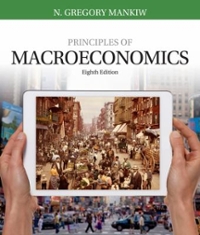Question
Respond to: There are a lot of opportunities in the TPP for states to grow their economies and add jobs. A state's ability to offer
Respond to:
There are a lot of opportunities in the TPP for states to grow their economies and add jobs. A state's ability to offer more employment to its citizens increases with an improvement in GDP (Jackson, 2016). This is because companies will need to hire more employees when their revenue rises because of rising demand in both domestic and international markets to maintain the current levels of supply and demand. This will help a nation's unemployment rate significantly decline. The combined access to the "TPP" nations through reduced trade barriers and increased market access in the member countries is one of the main advantages of the Trans-Pacific Partnership. To allow goods from every other nation to flow into the market, the member nations will gradually reduce customs taxes, subsidies, and other onerous trade barriers.
To improve intellectual property protection for a broad variety of products, the United States and eleven other nations have negotiated under the Trans-Pacific Partnership (TPP). Since every nation needs strong intellectual property protection to attract foreign direct investment, particularly knowledge-based investments, Jackson (2016) argues that the Trans-Pacific Partnership (TPP) might be extremely beneficial to the U.S. economy. The potential negative effects of the TPP, especially concerning employment losses, have generated a great deal of criticism. Some people would suffer from job losses resulting from the TPP, especially those employed in the manufacturing sector, claim Gleeson et al. (2017). Due to their lower manufacturing costs, TPP members like Vietnam and Malaysia, for example, provide serious challenges to the US manufacturing sector. The demand for goods created in the United States will decline both domestically and globally if other nations can make and sell things at a lower cost than American producers. Consequently, the production output of American manufacturers would decline, which would lead to the inevitable layoff of people in this industry.
Production may be moved outside to nations with cheaper labor costs, which might lead to this kind of unemployment. This implies that a company may choose to employ people from a TPP member nation rather than from the United States. For instance, if hiring a Vietnamese worker is more cost-effective than hiring an American worker, the corporation may choose to do so. This would result in the employment of an American worker being eliminated. If there is a labor surplus in the region, the worker could have trouble finding other jobs, which could force them and their family into poverty.According to Gleeson et al. (2017), opponents of the pact frequently claim that it would make income disparity worse. Wage rate adjustments are one way that this may happen. It is believed that as pay rates represent the cost of labor, rises in the relative demand for highly skilled workers are typically referred to as increases in high-skilled worker wages. This is because highly competent workers produce more than workers with lower skill levels, increasing the value of their labor. Employing high-skilled individuals may be more cost-effective for businesses than hiring lower-skilled workers if they can pay them more than they used to. Many who oppose the pact claim that it would make income inequality worse (Gleeson et al., 2017). Changes in pay rates are one way that this may happen. As the wage rate is the cost of labor, it is claimed that rises in the relative demand for highly trained workers should be referred to as an increase in the high-skilled worker wage rate. This is because the labor of highly trained workers becomes more valued since they are more productive than those with lower skill levels. Businesses may decide to allocate resources to hire highly talented personnel rather than lesser skilled individuals if they can pay these workers more than they did in the past. After doing my analysis, I conclude that joining the TPP would be beneficial for the US and that the risks are outweighed by its considerable potential benefits. The United States may forge stronger strategic alliances, foster innovation, improve economic prospects, and maintain its leading position in influencing international commerce by enlisting in the Trans-Pacific Partnership (TPP). The advantages might be substantially greater than the disadvantages. Furthermore, the US must take the initiative to establish standards and laws that represent its interests and values considering the emergence of economic giants like China. By setting a good example, the US can shape trade agreements and advance an international trading system based on norms.
Step by Step Solution
There are 3 Steps involved in it
Step: 1

Get Instant Access to Expert-Tailored Solutions
See step-by-step solutions with expert insights and AI powered tools for academic success
Step: 2

Step: 3

Ace Your Homework with AI
Get the answers you need in no time with our AI-driven, step-by-step assistance
Get Started


